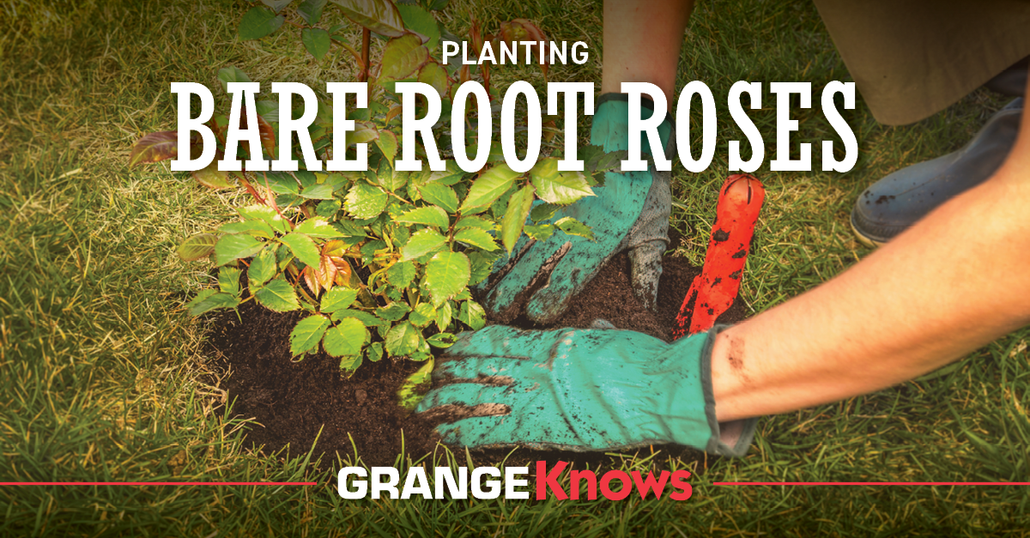
Planting Bare Root Roses
Posted by Grange Co-op on 31st Jan 2022
Planting Bare Root Roses
Roses provide breathtaking sights and smells to landscaping. In addition to bringing immense beauty into the yard or garden, roses are simple to plant and will continue to bloom year after year! Roses are easy to grow and have the option to choose between different rose varieties. In this GrangeKnows article, we’re going to explain how easy they are to plant and how to choose the best plant for your garden.
PICKING YOUR ROSE PLANT
Roses prefer full sun; begin by choosing a location with six hours or more of sun. If this type of location isn’t feasible, there are some types of roses that are adaptable to partial shade. Check with one of our Grange Gardening Experts to confirm the variety of rose bush you wish to plant is appropriate for the location. Generally, the more sun, the more bloom you’ll get out of your roses. There are a variety of different kinds of roses. For example, Hybrid Tea roses have a larger, single flower on a long stem, while Floribunda roses produce a cluster of smaller flowers along their stems. You can also choose between a shrub rose or a climbing rose. A shrub rose will usually stay more compact, are great for low maintenance landscaping, and are known to be disease resistant. Climbing roses are fast growing and will trail over fences and trellises. Choose the look you would like for your yard to pick out your perfect rose!
PLANTING
Once you have chosen your desired variety of rose bush and found a suitable location, you can prepare to plant. First, remove the plastic bag surrounding the biodegradable fiber pot. Water as necessary to ensure the soil remains moist until ready to plant. It is important the rose’s roots do not dry out. Begin by digging a hole that is larger than necessary, often this is about 2 feet wide. The depth of the planting hole should fit the height of the rose pot. If you are in a zone where the ground does not freeze (such as zone 7-8) Check what zone you are in with this USDA Zone Map. The graft of the rose should be flush with the surrounding soil line. This ensures the graft receives plenty of air circulation, aiding in the rose’s development. The grafted part of the rose bush looks like a knot or bump just above the root system. Once you have the appropriate size hole dug, prepare to plant your rose bush by making 4 six-inch cuts down the sides of the pot and 2 two-inch cuts in the bottom of the pot. This is done to encourage root growth. To give your rose the best chance at success, use Gardner and Bloome Organic Purely Compost to back fill and amend the soil the rose will grow in. Lightly tamp the soil to remove any air pockets and give the root system support. Once the entire planting hole is back filled, use some of the remaining mix to create a ring around each rose bush. This will form a bowl around the plant to catch and hold water.
After planting, if any of the canes (stocks) of the rose bush are damaged, pruning these away will stimulate new growth. Your rose bush should remain moist, but not too wet over the next few weeks. Consider purchasing a moisture meter if there is concern you might fall victim to a too-much or too-little watering schedule. Continue to water as needed—approximately once a week—this will stimulate the rose bush to develop a deep root system. Once your rose is established it is a good idea to fertilize your roses a couple times a year. The best time to fertilize is early to mid-spring. Fertilizing will help develop new leaves and canes resulting in more flowers! Gardner and Bloome has an organic Rose and Flower fertilizer made specifically for your rose bushes.
RECOMMENDATIONS
Roses we recommend and currently carry include Hybrid Tea, Grandiflora, Floribunda, Shrub and Climbing and more! Come in to any of our locations and speak with a Grange Gardening Expert for answers to questions you may have about growing roses!
